Legends of the Lone Star: The Texas Rangers – The Old West and Historical Controversy have a showdown.
June 18, 2023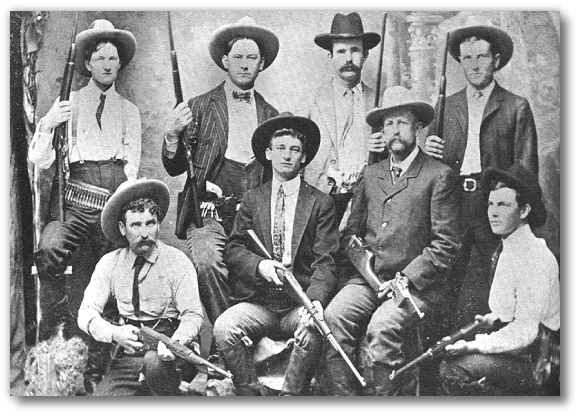
Texas Rangers armed with Colt Peacemakers and 1894 Winchester rifles and carbines of various barrel lengths and calibers.
In the vast expanse of the American West, where lawlessness prevailed and danger lurked around every corner, a legendary force emerged to bring justice to the frontier. The Texas Rangers have a long and storied history, dating back to Stephen F. Austin and his “Old Three Hundred” settlers, who created the beginnings of the Rangers in 1823 by appointing a handful of local settlers as “rangers” so as to maintain peace, order, and protection from raids on settlements by local American Indian tribes. This small, well-equipped group of men was the first formal law enforcement and paramilitary agency in North America, and nearly 200 years later they are still the oldest such agency in the United States.
While the men of the Rangers may have looked different over the years and have used different equipment and strategies, their courage and bravery in the face of danger have never faltered. Here we explore the history of the Texas Rangers, taking a comprehensive look at their modest beginnings to their eventual rise to legendary status in both America and around the world.
Historian and former head of the Texas Historical Commission, T.R. Fehrenback (1925~2013) explains the unique character of the Rangers:
The Rangers were to be described many times, at first as state troops, later as a police force or constabulary. During most of the 19th century, they were neither. They were apart from the regular army, the militia or national guard, and were never a true police force. They were instead one of the most colorful, efficient, and deadly band of irregular partisans on the side of law and order the world has seen. They were called into being by the needs of a war frontier, by a society that could not afford a regular army. Texans passed in and out of the Rangers regularly; in the early years, a very high proportion of all west Texans served from time to time. If they bore certain similarities to Mamelukes and Cossacks, they were never quite the same.
Pioneering Beginnings (1823-1836)
In the early 19th century, as Texas transitioned from Mexican rule to a Republic, Stephen F. Austin conceived the idea of a specialized force to safeguard the region’s settlers. With a commitment to pay them $1.25 per day out of his own pocket, Austin’s vision materialized with the establishment of the Texas Rangers. Initially, a group of ten men, the Rangers, patrolled the vast frontier, countering the threat posed by hostile Native American tribes and lawless outlaws. Their early exploits focused on border defense, acting as a vital bulwark against raids and incursions.
Mike Cox, writes in the June 2023 edition of “True West” magazine…
For years, men who rode to safeguard the frontier were not always called Rangers. Early descriptors ranged from “mounted gunmen” to ‘spies” to “minutemen” Nor have the Rangers always been about law and order. For their first half century-plus, they saddled up to protect Texas from hostile Indians, not track outlaws. One absolute is that over their two centuries of history they have been both revered and reviled.
While Austin generally is credited with conceptualizing the Rangers, a young, slight man from Tennessee who came to Texas in 1838 as a surveyor soon fathered their reputation.
But the Rangers were well regarded by most 19th-century Texans-except American Indians fighting to retain their land, outlaws and penurious state lawmakers. The (Marshall) Texas Rețpublican editor wrote in 1855:
As a surveyor, John C.”Jack” Hays had several close calls with hostile Indians. He soon mixed his work with service as a volunteer Ranger, but it was not until January 1841 that the new Republic of Texas appointed him as a Ranger captain. “In Texas the name..”Ranger is a household word…associated with noble deeds. He is the defender of the frontier; the protector of the defenseless; the avenger of..wrongs. He endures privations and hardships; sleeps it may be in the wilderness … knows not what moment a lurking savage may shoot him from his horse and scalp him; yet…he is as well contented as if he had all the luxuries of life around him.”
That journalist referred to Rangers in the singular, but while they often worked alone, then as now Rangers operated in organized companies. Still, the attitude and actions of fewer than a score of men molded the Rangers’ reputation early on. They were men who would not stand down.
John Coffee “Jack” Hays and the Ranger Tradition
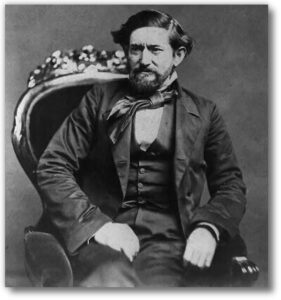
John Coffee Hays was one of the most famous Texas Rangers of all time. He joined the Rangers in 1833 and served for more than 20 years.
Hays, originally from Tennessee, arrived in San Antonio in 1837, shortly after Texas achieved its independence from Mexico. By the young age of 23, in 1841, he held the position of a Ranger captain. With fearlessness in battle and adept leadership, Hays gained renown for his defense of Texans against raids and assaults by Native American (Comanche) tribes and Mexican outlaws. Hays emerged as the iconic figure representing the Rangers during the era of the Texas Republic. Throughout the Mexican War (1846-48), Hays’ Rangers undertook scouting missions and safeguarded the supply and communication routes of the United States, warding off attacks by Mexican guerrillas. They fought alongside regular U.S. army troops, establishing a national reputation for their courageous acts.
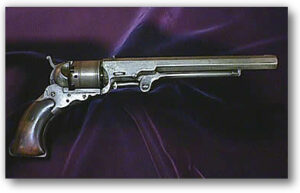
Colt No. 5 Texas Paterson Revolver
The Colt Revolver: The Rangers’ Most Famous Weapon
The advent of the Colt Revolver in the mid-19th century revolutionized the Texas Rangers’ approach to law enforcement. The six-shooter’s rapid-fire capabilities and reliability gave Rangers a distinct advantage in confrontations with outlaws and bandits. Armed with this new weapon, the Rangers became even more formidable in their pursuit of justice, earning the respect of friend and foe alike. In late 1846, Sam Walker made some simple suggestions to improve Colt’s revolver design, and the upgraded “Walker Colt” became the deadliest weapon of the war. The Colt Revolver was so successful that the Rangers adopted it as their official sidearm.
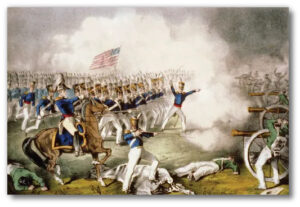
War between the U.S. and Mexico (April 1846–February 1848) stemmed from the U.S. annexation of Texas in 1845.
The U.S. – Mexican War (1846-48): The Rangers Take the Fight to Mexico
The Texas Rangers played a pivotal role in the U.S. – Mexican War, contributing to the American victory. The Rangers were part of a U.S. army of approximately 15,000 men who invaded Mexico and fought to gain control of the land. Under the command of notable Ranger leaders such as John Coffee Hays and Samuel Walker, they fought valiantly in battles such as the Siege of Vera Cruz and the Battle of Monterrey. Their bravery and combat expertise showcased the Ranger ethos of resilience and adaptability.
The John Ford Campaign: Decimating the Comanche Threat
One of the most significant campaigns in Ranger history was led by Captain John Salmon “Rip” Ford. From 1858 to 1859, Ford spearheaded a six-month offensive against the Comanche Indians, who had long posed a grave threat to settlers in Texas. Ford’s relentless pursuit and strategic acumen culminated in a series of victories, significantly weakening the Comanche hold on the region and providing a safer environment for settlers. The success of the campaign led to the establishment of the Frontier Battalion in 1851, which was responsible for patrolling the Texas frontier.
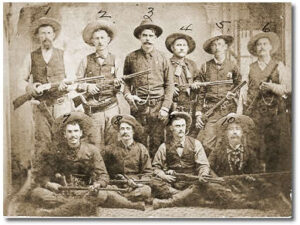
Some members of the Frontier Battalion. Image courtesy of the Texas Ranger Hall of Fame and Museum.
Creation of the Frontier Battalion
In 1874, the Texas Legislature established the Frontier Battalion, the first formal law enforcement agency of the Texas Rangers. The new unit was made up of six companies. These companies were made up of 150 Rangers, who were assigned to patrol and protect Texas from crimes such as cattle theft and murder. The newly formed Frontier Battalion was placed under the command of Captain Leander McNelly, whose first mission was a five-month assignment chasing cattle thieves in south Texas.
Following the five-month mission, most of the Frontier Battalion was reassigned to the Texas-Mexico border to fight against bandits and smugglers in the area. This became their main mission for the next two years. During this time, they successfully managed to break up smuggling rings and bring many of the criminals to justice. They also defended settlers against hostile Native American tribes and often held joint operations with the Mexican government authorities. This had a major impact on maintaining law and order on the Texas-Mexico border, and by 1876 the Frontier Battalion had become one of the most respected law enforcement agencies in Texas.
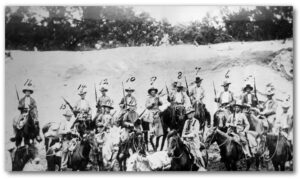
The Porvenir Massacre. Co. E. on horseback, taken May 3, 1918, eight miles west of Del Rio. 1983/112 R-447-1, Texas Department of Public Safety photographs.
The 1918 Porvenir Massacre: Dark Stain on Ranger History
While the Texas Rangers played an essential role in maintaining law and order, their history is not without blemishes. The 1918 Porvenir Massacre stands as a dark stain on the legacy of the Texas Rangers. In January of that year, a group of Rangers under the command of Captain J.M. Fox conducted a brutal raid on the village of Porvenir, a predominantly Mexican-American community. The Rangers accused the residents of being involved in cattle theft and smuggling, but the ensuing raid resulted in the deaths of at least fifteen men and boys.
In 1979, the Texas Rangers conducted an internal investigation into the massacre, but the investigation was inconclusive. The Rangers concluded that there was not enough evidence to determine whether the killings were justified, but they did not exonerate the Rangers of any wrongdoing. In 2009, the Texas Legislature created the Porvenir Massacre Investigation Committee to investigate the massacre. The committee’s report, which was released in 2011, concluded that the Rangers had committed a “massacre” and that the killings were “unjustified.” The report also called for the Rangers to apologize for the massacre and to pay reparations to the victims’ families.
The Texas Rangers have not apologized for the Porvenir Massacre, and they have not paid reparations to the victims’ families. However, the agency has acknowledged that the massacre was a dark chapter in its history, and it has taken steps to improve its relationship with the Mexican-American community.
The Porvenir Massacre highlighted the racial tensions and abuses of power that marred the Ranger’s history. It led to public outcry and calls for reform, ultimately leading to investigations and reforms within the organization. While the incident remains a tragic episode, it serves as a reminder of the importance of holding law enforcement accountable and striving for justice and equality.
Archaeological dig provides a new look at the Porvenir Massacre.
One of the .45 Colt bullets found at the massacre site. Photo by Glenn Justice.
Glenn Justice started researching the story of the massacre in the late 1980’s and presented a paper about it about it to the West Texas Historical Association before publishing his book “Revolution On The Rio Grande” that included a chapter on the massacre in 1992. Slowly the paper evidence concerning the massacre grew to the point that it left little or no doubt that the massacre had actually taken place and who had been involved.
Overall everyone who took part in the archaeological work at Porvenir considered the finds to be exceptional. Principle archaeological investigator David Keller summed up the project “Considering that I was skeptical that we would find additional materials, I was pleasantly surprised by the volume and consistency of our finds. The intensive survey also revealed a highly patterned artifact distribution. I can say with a fair degree of confidence that the artifactual distribution, the types of artifacts, all strongly conform to the hypothesis that this was the site of the Porvenir Massacre of 1918. The findings also strongly implicate the U.S. Cavalry.
Into the 20th Century: Bonnie and Clyde and the Rangers
As the 20th century dawned, the Texas Rangers continued to evolve and adapt to the changing landscape of law enforcement. One prominent Ranger from this era was Frank Hamer, a former Ranger captain who played a significant role in the pursuit and ultimate capture of the notorious criminals Bonnie Parker and Clyde Barrow. Hamer’s relentless pursuit and strategic planning demonstrated the enduring spirit and tenacity of the Texas Rangers in the face of formidable challenges.
Even Douglas Swanson, the controversial author of “Cult of Glory: The Bold and Brutal History of the Texas Rangers,” notes the Rangers’ many contributions to the Lone Star State … admittedly, one of his few positive comments about the Rangers:
They helped pacify an extraordinarily wild and savage place — Texas. Criminals were rampant across frontier Texas. They helped bring them to justice. They were really valuable scouts and guerrilla fighters in the Mexican war … (they’ve) done some really good stuff … providing valuable service to small-town departments. They helped break the Texas Youth Commission sexual abuse scandal. They brought a murdering priest to justice. They’ve done extraordinarily strong work on cold cases. So, yes, they’ve done a lot. Texas would not be the same without them. There’s no doubt about that. And they are deeply woven into the history of the state.
Legacy and Conclusion
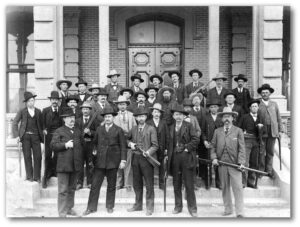
Texas Rangers, c. 1890s. William Deming Hornaday Photograph Collection/Courtesy of Texas State Library and Archives Commission (image no. 1975070_1071)
The Texas Rangers have come a long way since their humble beginnings in 1823. Their legacy as North America’s oldest state law enforcement agency endures, inspiring countless stories, books, and movies. Today, the Texas Rangers remain an integral part of the Texas Department of Public Safety, dedicated to upholding the law, preserving peace, and protecting the people of the Lone Star State.
The Rangers’ storied history is marked by courageous individuals, from Stephen F. Austin and Jack Hayes to John Ford and Frank Hamer, who embodied the spirit of the Wild West and fought for justice on the frontier. While their history includes both triumphs and tragedies, the Texas Rangers symbolize the indomitable spirit of Texas itself—an unwavering commitment to freedom, justice, and the defense of the people.
As we look back on the chronicles of the Texas Rangers, we honor their contributions to the development of law enforcement in North America. They have left an indelible mark on the history and culture of the Lone Star State, forever etching their place in the annals of American law enforcement. The legend of the Texas Rangers lives on, serving as a reminder of the power of determination, bravery, and a commitment to upholding the principles of justice and order.
Additional research sources:
Special Collections & University Archives: Texas Rangers (early history)
From the University of Texas Rio Grande Library.
History.com: 8 Famous Texas Rangers.
Texas Ranger Association Foundation website.
Texas Rangers Genealogy Trails
The Lone Ranger (TV Series, 1949-1957)
THE CONTROVERSY
“Cult of Glory: The Bold and Brutal History of The Texas Rangers.”
At Amazon.
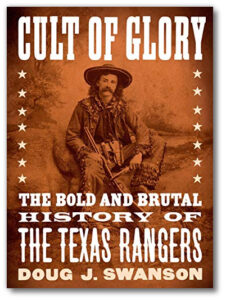
“Swanson has done a crucial public service by exposing the barbarous side of the Rangers.” —The New York Times Book Review
The controversy surrounding Doug Swanson’s book, “Cult of Glory: The Bold and Brutal History of The Texas Rangers,” stems from its perceived unbalanced and biased portrayal of the Rangers. One scholar even went as far as to label it “an example of advocacy journalism rather than historical analysis.” It is important to critically examine Swanson’s approach to understand why these accusations have been made.
One of the main criticisms leveled against Swanson’s book is its lack of balance. The author focuses primarily on the darker aspects of the Texas Rangers history, portraying them as a brutal and oppressive force. While it is important to acknowledge and address the past wrongdoings of any institution, it is equally important to provide a balanced perspective by also highlighting their positive contributions. By failing to do so, Swanson’s work gives an imbalanced view that does not accurately reflect the complete history of the Texas Rangers.
It is crucial to note that while criticism is always expected in historical analysis, it is important for scholars to maintain a balanced and objective perspective. Furthermore, Swanson’s use of the “Texas Sharpshooter Fallacy” further contributes to the distorted portrayal of the Rangers. The Texas sharpshooter fallacy is an informal fallacy that arises when a person has a large amount of data at their disposal but only focuses on a small subset of that data … differences in data are ignored, but similarities are overemphasized, thus, a false conclusion is inferred.
Swanson’s book is deemed distorted due to its failure to present a comprehensive and accurate account of the Texas Rangers history. By cherry-picking specific incidents and anecdotes, Swanson presents a skewed representation that fails to provide a balanced understanding of their role in Texas history. This limited research undermines the credibility of his arguments and raises questions about the accuracy of his overall narrative. By not conducting a thorough and rigorous examination of various primary and secondary sources, Swanson’s work lacks the depth and nuance necessary for a well-rounded historical analysis.
It is essential for readers to approach this book with skepticism and to seek out additional perspectives to gain a more comprehensive understanding of the subject matter. Historical analysis should be grounded in rigorous research and a commitment to presenting a fair and accurate representation of the past.
Although there were plenty of positive reviews on Amazon for Swanson’s book, some responses were intended to “balance the scales.”
Well written and well-researched…but that’s about it.
The author did a great job doing his research and writes in a very fluent and understanding manner. That’s about all I can say that is good about the book. This is one of the most unbalanced and biased book that I have ever read.
The author, from the beginning, is on a social justice rant and along the way decided to bash the image of the Texas Rangers. I am all for social justice, but the book is about the Texas Rangers. Time and again the author goes into great detail explaining how a certain social injustice–unrelated to the Texas Rangers– was perpetrated by American society against Blacks, Native Americans, or Mexican Americans. Then, he ties the Texas Rangers into an event that they were called upon to deal with on the heels of the injustice and paints them more often than not as nonchalant, racist, thugs. He obviously is focused much more on what the Rangers did wrong than what they have done right since the early 1800’s.
I am shocked, shocked to be told that men in war, especially those drawn to it, and requisite to its waging, can be wantonly violent as well as chivalrous, rapacious as well stalwart under stress. Surely a surprise. This book will sell well given the current heightened, and overdue, attention to racial inequities and violence in America, but basically is a recounting of previously told tales from a parallax view, and no doubt will profit from the current zeitgeist of national self flagellation and fashionable metaphoric wearing of a hair shirt over lamentable and admittedly tragic episodes in our collective history. The book thus is a literary waving of the proverbial bloody shirt over our past sins and is more likely to provoke righteous indignation than thoughtful proposals for securing justice today for all citizens and indeed immigrants, legal or otherwise.
And if a comment could earn Amazon’s “Hold on there Hoss” award, it would be Dave D…
It would not surprise me to read that the author this book, Doug J. Swanson, had been found lynched in his living room in Pittsburgh by a renegade band of The Daughters of the Texas Rangers. The book is the historical-heresy equivalent of writing that the Lone Ranger and Tonto were gay lovers and that “Kemo Sabe” translates as “Adorable Bunkmate.” An online reviewer called this book “a hatchet job.” It’s a lot more than that. It’s a hatchet-axe-Bowie knife-bandsaw-switchblade-six gun-Sharps rifle-shotgun-Derringer-poison arrow-arsenic-strychnine-hemlock-curare-hypodermic-crossbow-baseball bat-branding iron-car bomb-job of a book.
Having written a few books myself, I know that the job of a writer is to inform, educate, and entertain the reader, but I also know that it is not the job of a writer to bludgeon the reader into submission with infinite negativity. I stopped reading this book right after murder number 3,042 on page 289 out of 453, totally convinced that the Texas Rangers are ten times worse than the Ku Klux Klan, the Nazis, SPECTRE, the Never-Trumpers, the Communists, and the Muppets combined. Okay, Doug, you’ve made your point, so let me give you some career advice: don’t take that job offer from Texas Tech in Lubbock.
From the Journal of the Texas Supreme Court Historical Society…

RICHARD B. McCASLIN, TSHA Professor of Texas History at the University of North Texas, is the author or editor of eighteen books, seven of which won awards, as well as numerous book chapters and articles. A Fellow of the TSHA, he is also an Admiral in the Texas Navy and has received several awards for academic service from historical organizations, including the Civil War Round Tables in Dallas, Fort Worth, and Shreveport.
McCaslin offers a review…
Swanson is no more concerned about research than objectivity. Rather than dig, he spends a lot of time discussing Rangers as they appear in movies and fiction. While the latter are useful for Texans who want to think of their state as unique and larger-than-life, such sources are not taken seriously by those who study their history on a substantive level. True scholars in the past sixty years have been working in the tremendous archives on the Rangers that have become more readily available, such as the records of the Texas Adjutant General’s Office, which was the administrative home of the Rangers during their first century. Thanks to the internet, newspapers have now become more accessible, too. Swanson rarely cites these sources, and he also ignores many historical works based upon them. His discussion of men such as Stephen F. Austin and John S. Ford would have been improved by using more recent biographies of them, while better understanding of John R. Hughes, John H. Rogers, and J. Abijah Brooks, gained from books about them, might have led Swanson to do more than just mention them. The same can be said about many events, ranging from the Great Comanche raid of 1840 to the clean-up of San Augustine in 1935. Instead, the author resorts repeatedly to criticizing Webb’s 85-year-old work or uses already disproved anecdotes from even older books. While it can be argued that tedious research is not needed for a bold and brutal history, if a work is to be taken seriously as a corrective, it has to at least attempt to address the entirety of its subject, and the scholarly literature on it.
The full excerpt below from Vol. 10, No. 4, Summer 2021, of the Journal of the TEXAS SUPREME COURT HISTORICAL SOCIETY.
